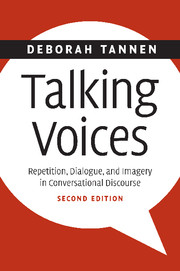Book contents
- Frontmatter
- Contents
- Acknowledgments
- 1 Introduction to first edition
- Introduction to second edition
- 2 Involvement in discourse
- 3 Repetition in conversation: toward a poetics of talk
- 4 “Oh talking voice that is so sweet”: constructing dialogue in conversation
- 5 Imagining worlds: imagery and detail in conversation and other genres
- 6 Involvement strategies in consort: literary nonfiction and political oratory
- 7 Afterword: toward a humanistic linguistics
- Appendix I: Sources of examples
- Appendix II: Transcription conventions
- Notes
- List of references
- Author index
- Subject index
Appendix II: Transcription conventions
Published online by Cambridge University Press: 23 December 2009
- Frontmatter
- Contents
- Acknowledgments
- 1 Introduction to first edition
- Introduction to second edition
- 2 Involvement in discourse
- 3 Repetition in conversation: toward a poetics of talk
- 4 “Oh talking voice that is so sweet”: constructing dialogue in conversation
- 5 Imagining worlds: imagery and detail in conversation and other genres
- 6 Involvement strategies in consort: literary nonfiction and political oratory
- 7 Afterword: toward a humanistic linguistics
- Appendix I: Sources of examples
- Appendix II: Transcription conventions
- Notes
- List of references
- Author index
- Subject index
Summary
Examples are presented in poetic lines rather than prosaic blocks. I believe that this better captures their rhythm and makes the text easier to read. Lines represent intonation units, to capture in print the natural chunking achieved in speaking by a combination of intonation, prosody, pausing, and verbal particles such as discourse and hesitation markers. (See Chafe 1986 for a discussion of the multidisciplinary research that documents the universality of such chunking in oral discourse.) In transcription, punctuation represents intonation, not grammatical conventions. In most cases I depart from my previous practice, and, I believe, the most common practice, of representing selected expressions in reduced form, such as “gonna” for “going to,” “hadda” for “had to,” “woulda” for “would have,” because I have been convinced by Preston (1982) that such nonstandard spelling is always inconsistently applied and has the effect of giving readers a negative impression of the speaker, an impression that does not follow from the casual pronunciation in speech. Preston (1985) found that readers consistently rate the social class of speakers lower if their conversation is transcribed using such nonstandard spellings. Because such reduced phonological realizations are standard in casual speech, representing them by a nonstandard spelling misrepresents them.
- Type
- Chapter
- Information
- Talking VoicesRepetition, Dialogue, and Imagery in Conversational Discourse, pp. 193 - 195Publisher: Cambridge University PressPrint publication year: 2007

